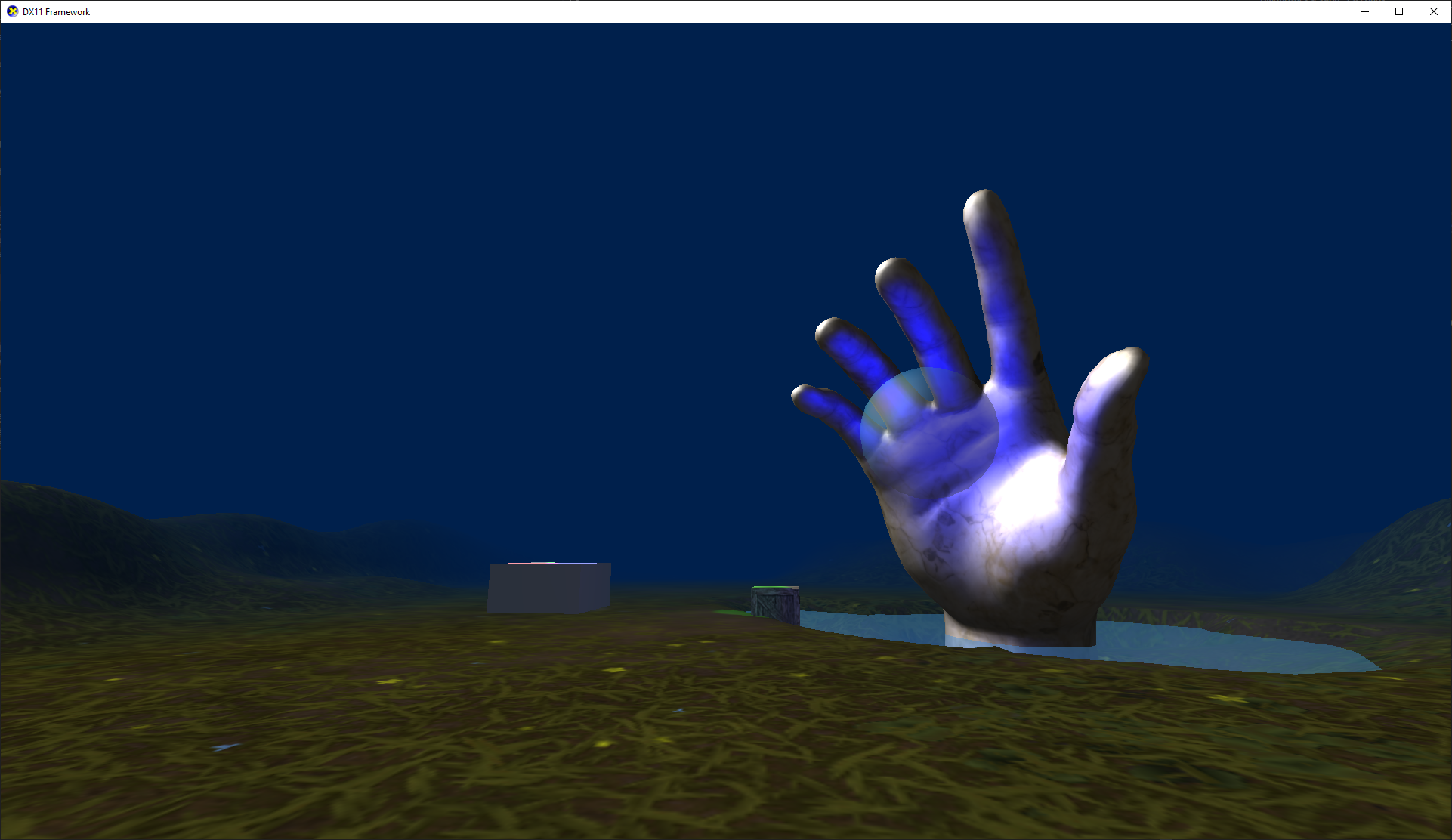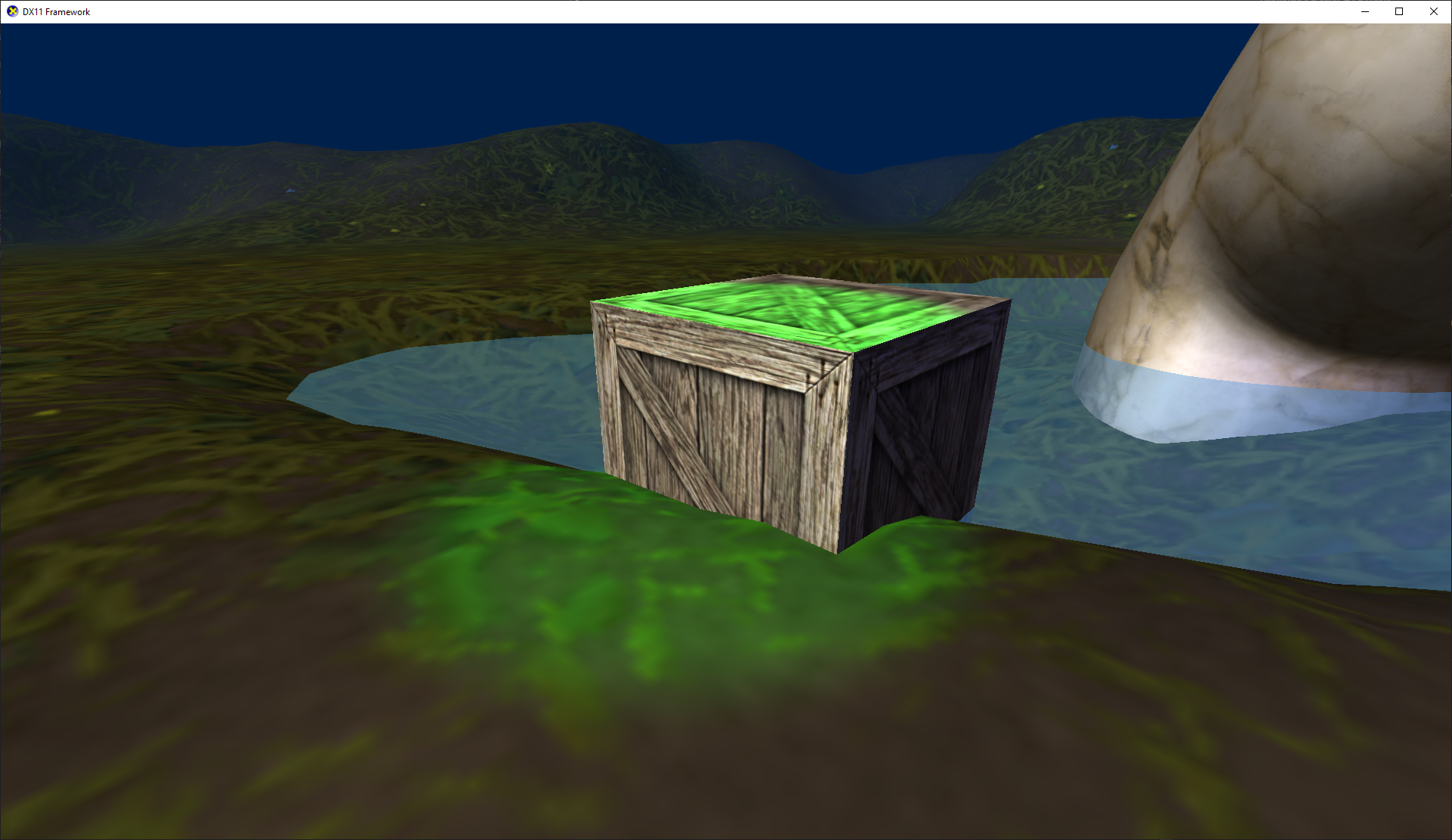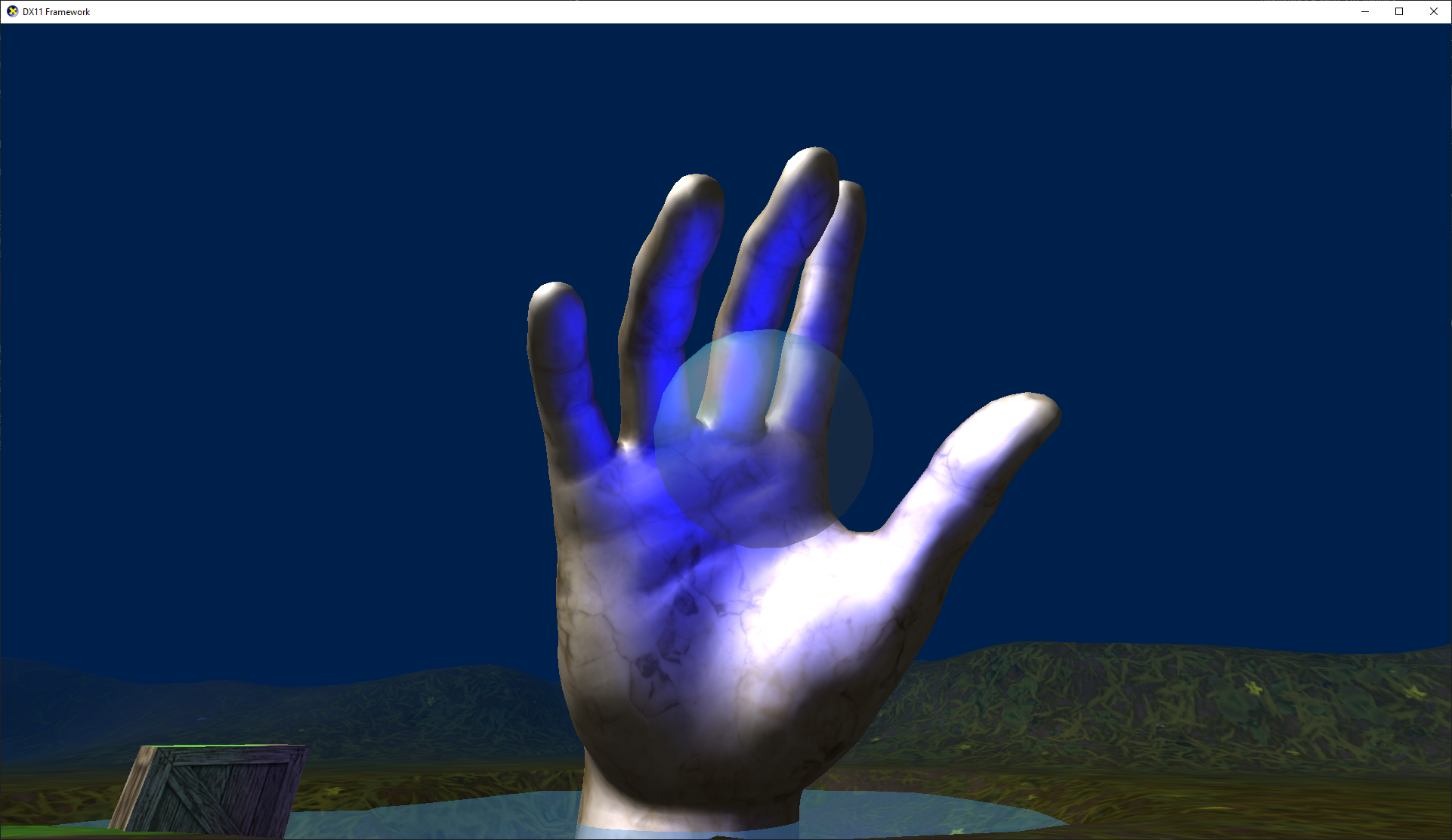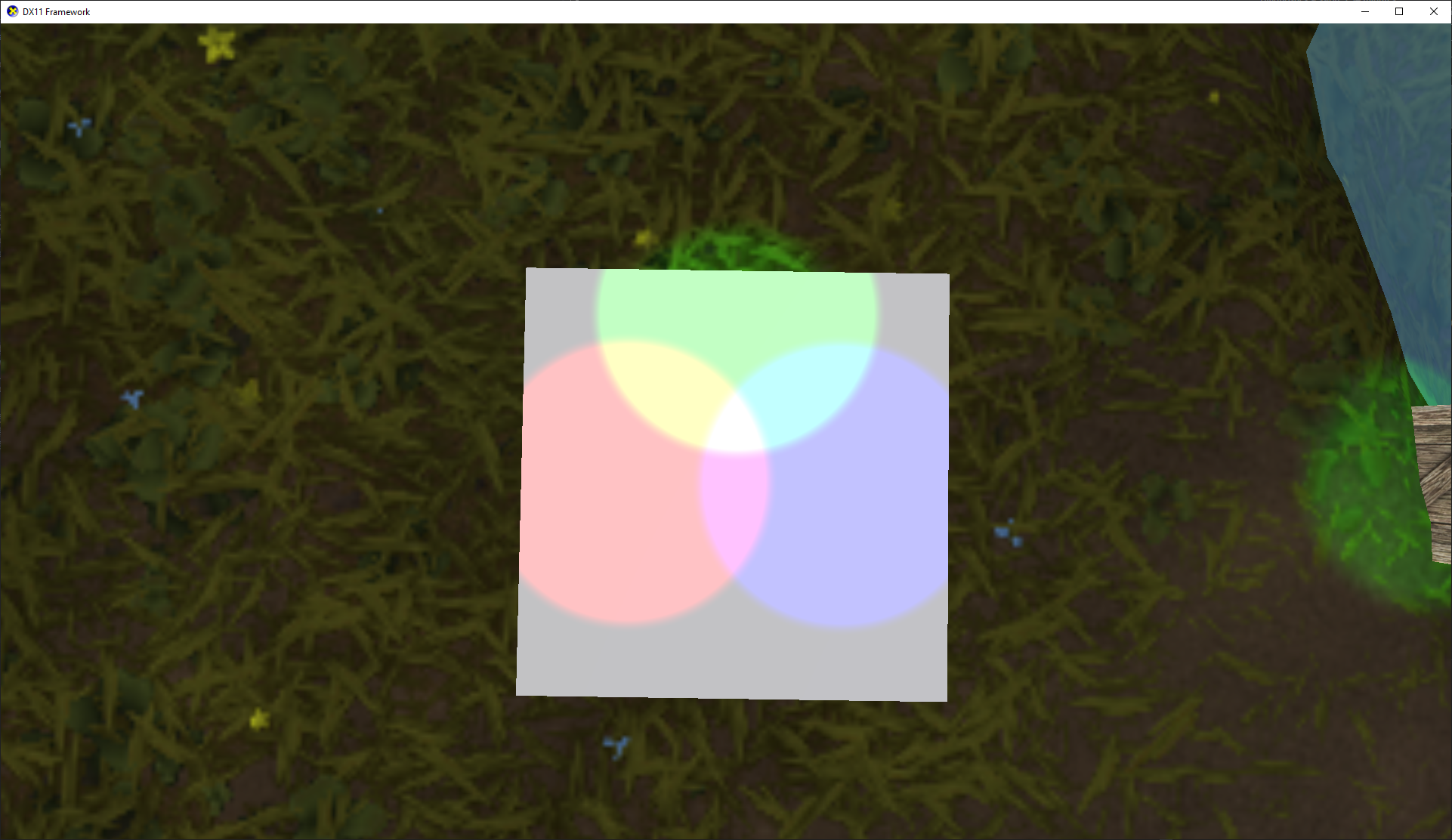DirectX 11 Render Pipeline
Created December 2022
What is it?⌗
- Engine: My own!
- Language: C++ and HLSL
This small application is a project developed for university that involves learning how the DirectX 11 render pipeline works and how to implement various lighting techniques.
Specifically, the following features have been implemented:
- Reading from YAML to add materials, cameras, scenery, and other settings without recompiling.
- Blinn-Phong shading, including ambient, diffuse, and specular lighting.
- Materials include albedo and specular map textures with lighting interaction.
- Point, Spot, and Directional lights, configurable via YAML.
- A free camera and normal camera, switchable using the number keys.
- Pixel colour blending for translucent objects
- Fog that also uses colour blending.
How do the lights work?⌗
One of the problems I had to solve was how to deal with different types of lights on the same shader. To do this, I made a struct that represents directional, point, and spotlights at the same time, using an enum to determine which light the struct contains data for.
enum LightType
{
DIRECTIONAL_LIGHT = 0,
POINT_LIGHT = 1,
SPOT_LIGHT = 2
};
struct Light
{
public:
XMFLOAT4 Color;
// -------------- 16 bytes
XMFLOAT3 Direction;
LightType lightType;
// -------------- 16 bytes
XMFLOAT3 Position;
FLOAT Attenuation;
// -------------- 16 bytes
FLOAT SpotAngle;
private:
XMFLOAT3 _padding;
};
As the lights are configurable using a YAML file, they need to be read using the yaml-cpp library when the program loads. The lighting section of the config file looks like this:
lighting:
ambientLight: [0.2, 0.2, 0.2, 1]
directionalLights:
- direction: [-0.5, 0.5, 0.1]
color: [0.8, 0.8, 0.8, 1.0]
pointLights:
- position: [4.0, 3.0, -4.0]
color: [0.0, 0.0, 1.0, 1.0]
attenuation: .5
spotLights:
- position: [2, 5, 0]
color: [0, 1, 0, 1]
attenuation: 0.1
direction: [-0.2, -1, 0]
spotAngle: 10 # degrees
- position: [-4, 5, 0]
color: [1, 0, 0, 1]
attenuation: 0.01
direction: [0, -1, 0]
spotAngle: 10 # degrees
[...]
The program then reads the YAML and loads the lights into memory. It also keeps track of how many lights in total are being loaded.
void Application::LoadSceneFromConfig()
{
[...]
// Read lights
int i = 0;
for (YAML::Node dlNode : _config["lighting"]["directionalLights"])
{
Light light;
light.lightType = DIRECTIONAL_LIGHT;
light.Color = dlNode["color"].as<XMFLOAT4>();
light.Direction = dlNode["direction"].as<XMFLOAT3>();
_lights[i] = light;
i++;
}
// Read point lights
for (YAML::Node plNode : _config["lighting"]["pointLights"])
{
Light light;
light.lightType = POINT_LIGHT;
light.Color = plNode["color"].as<XMFLOAT4>();
light.Position = plNode["position"].as<XMFLOAT3>();
light.Attenuation = plNode["attenuation"].as<float>();
_lights[i] = light;
i++;
}
// Read spotlights
for (YAML::Node slNode : _config["lighting"]["spotLights"])
{
Light light;
light.lightType = SPOT_LIGHT;
light.Color = slNode["color"].as<XMFLOAT4>();
light.Position = slNode["position"].as<XMFLOAT3>();
light.Attenuation = slNode["attenuation"].as<float>();
light.Direction = slNode["direction"].as<XMFLOAT3>();
light.SpotAngle = slNode["spotAngle"].as<float>();
_lights[i] = light;
i++;
}
_numLights = i;
}
When the rendering begins, it takes the information of those lights and passes it to the constant buffer, ready to be used by the shader:
for (GameObject* go : _orderedGameObjects)
{
// Set the world matrix
XMMATRIX world = XMLoadFloat4x4(go->GetWorld());
// Make a constant buffer template with new shader variable values
ConstantBuffer cb;
cb.World = XMMatrixTranspose(world);
cb.View = XMMatrixTranspose(view);
cb.Projection = XMMatrixTranspose(projection);
cb.AmbientLight = _ambientLight;
cb.fog = _fog;
// copy lights to constant buffer
std::copy(std::begin(_lights), &_lights[_numLights], std::begin(cb.lights));
cb.numLights = _numLights;
[...]
// Set the constant buffer on each shader so it uses the piped in data
_pImmediateContext->VSSetConstantBuffers(0, 1, &_pConstantBuffer);
_pImmediateContext->PSSetConstantBuffers(0, 1, &_pConstantBuffer);
// DRAW!
_pImmediateContext->DrawIndexed(go->GetMeshData()->IndexCount, 0, 0);
}
Now that the constant buffer contains the lights, we can finally use them inside the shader! To do this, I just use a switch-case statement to check the type of light in the array and calculate it accordingly.
This code is in HLSL:
// Lights
for (int i = 0; i < numLights; i++)
{
switch (lights[i].LightType)
{
case 0: // Directional Light
{
diffuse += Diffuse(lights[i], normalize(lights[i].Direction), input.NormalW);
specular += Specular(lights[i], viewerDir, normalize(lights[i].Direction), input.NormalW, input.TexCoord);
}
break;
case 1: // Point Light
{
float3 lightVector = lights[i].Position - input.PosW;
float distanceToLight = length(lightVector);
lightVector = normalize(lightVector);
float attenuation = Attenuation(lights[i], distanceToLight);
diffuse += Diffuse(lights[i], lightVector, input.NormalW) * attenuation;
specular += Specular(lights[i], viewerDir, lightVector, input.NormalW, input.TexCoord) * attenuation;
}
break;
case 2: // Spot Light
{
// Get direction of the light to the current pixel's world position
float3 lightVector = lights[i].Position - input.PosW;
float distanceToLight = length(lightVector);
lightVector = normalize(lightVector);
// Falloff as light vector gets close to maximum angle to normal
// Most code is derived (not directly copied) from here: https://www.3dgep.com/texturing-lighting-directx-11/#Spotlight_Cone
float minCos = cos(radians(lights[i].SpotAngle));
float maxCos = (minCos + 1.0f) / 2.0f;
float cosAngle = dot(normalize(lights[i].Direction), -lightVector);
float spotIntensity = smoothstep(minCos, maxCos, cosAngle);
float attenuation = Attenuation(lights[i], distanceToLight);
diffuse += Diffuse(lights[i], lightVector, input.NormalW) * attenuation * spotIntensity;
specular += Specular(lights[i], viewerDir, lightVector, input.NormalW, input.TexCoord) * attenuation * spotIntensity;
}
break;
}
Credits⌗
- yaml-cpp by Jesse Beder is licenced under the MIT licence.
- Patchy Medow texture by freepbr.com
- Hand Sculpture by re1monsen is licensed under Creative Commons Attribution
- Base framework provided by the university, as seen in the first commit.




